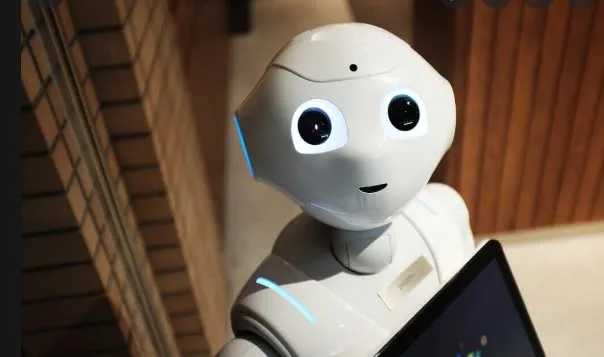Introducing technology to tend the tables Canberra Cafe resorts to unique measures by hiring a robot.
A Canberra Cafe decided to hire a robot to help them tend tables but not because they wanted to replace humans. Cafe owner Sam Vekiriya decided to do so because they were desperate for new workers.
Cafes and restaurants are finding it difficult to fill shifts because of a shortage of workers so the Canberra Cafe hired a robot to serve the tables and assist with the manpower shortage.
What exactly can the robot do?
- Serves food at tables
- Serve drinks at tables
- Returns dirty dishes to the kitchen
What’s the cost of this high tech robot servant?
After renting the robot for a trial period, Verkirya said he would purchase it at an upfront cost of around $30,000 and was well worth the investment.
Demand for autonomous workers in the hospitality sector
Robot workers are just one example of automation in hospitality.
According to the ABCs coverage the robot’s addition was still a novelty. However, experts believe there may be an increase in the number of these workers, particularly within the hospitality sector.
Vekiriya also noted that the robot’s novelty was a positive for the business. He stated that they had been looking for staff for over a year and half. Over the last three months is when the Cafe began to become desperate for new staff members.
As businesses recognise the benefits of robots in their services, automation is gradually becoming more mainstream in the hospitality sector. This was once a problem due to the high cost of robots and the lack of technology, but robots today offer a great solution as an affordable way for customers to receive accurate service.
The advantages of robots in hospitality
Robots in the hospitality industry bring on a lot of advantages including the fact that robots aren’t late and that robots don’t take breaks. Although they can’t connect personally to customers, they are a good way to make sure orders get from the kitchen to the customer’s table.
Robots are being used in certain tasks, such as delivering orders. Industries are now realising the benefits of automation. Although automation is an option for some companies, the Canberra Cafe chose to use it as an upgrade to their business.
COVID times robots mean less human contact, something guests are very comfortable with as it means the reduced possibility spreading the virus.
The recent pandemic has helped accelerate the adoption of technology within the hospitality industry in many ways. It was a much-needed boost (pun intended) in an industry that is notoriously slow to adopt new technology.
Hospitality patrons are now more tech-savvy than they were several years ago. Many people have claimed they’ve become more comfortable using technology rather than direct human contact.
Negative Opinions
Queensland resident Therese Douglas says she was in a café in Brisbane that had one of these robots recently.
“I thought it was terrible. Serve yourself and cleanup after yourself. It also nearly ran into some unsuspecting customers entering the cafe,” she said.
What can’t these robots do – Limitations
- Can’t clear the tables
- Can’t clean the tables
- Can’t clear spillage
- Human customer interaction
Will the human touch ever disappear?
The human touch is what will differentiate in hotels, cafes and restaurants. In the future, luxury hospitality could be dominated by human-centred service. Budget hotels could be run largely on AI, robotics, and a small staff. Luxury hotels, however, have a visible human workforce supported by robots behind-the scenes.
What is the future for Robots in Hospitality?
Worldwide, there are currently crisis levels of labour shortages in the hospitality industry. This isn’t a temporary problem and many hotels are now looking at technology to help them deliver outstanding service with fewer staff members.
Current examples of robots used in the hospitality sector defiantly confirms they have a place. They can be cited undertaking repetitive and even dangerous tasks while freeing up humans to provide the true hospitality components
The savings in labour costs and technology-derived efficiencies will be more than suffice to pay for the next-generation technology needed for hospitality robotization and automation.
Future use cases of robots could see the evolution of robots from waiting tables to potentially other tasks as well. As of current, the technology is still evolving and it’ll be everyone’s guess as to when humanoid robots or other types of robots could make their way into the hospitality industry.
According to the International Federation of Robots 2021 Service Robots Report, the pandemic caused the greatest increase in robot worker adoption in the transport and logistic sector. This was followed by the cleaning and medical services industries.
Andrew Aston director of Melbourne-based robotics consultancy Quantum Robotics says the use of hospitality robots was unlikely to lessen the need for human staff, despite their obvious novelty.
“Do they really offer an opportunity to reduce your staff headcount? Probably not,” he said.
The Australian Council of Trade Unions (ACTU) is the peak body of Australian unions. It represents approximately 1.8 million workers and their families.
In a statement to the ABC Secretary Sally McManus says that automation was far from a new phenomenon in many workplaces
“Robots would only be welcome in the workplace as a mechanism of improving the quality of life and safety of workers,” said McManus
Robots in the hospitality market is poised to grow by $ 291.74 million from 2022 to 2026, accelerating at a CAGR of 11.6% during the forecast period.
Along with QR menus and self ordering… can we no longer call the industry ‘hospitality?







